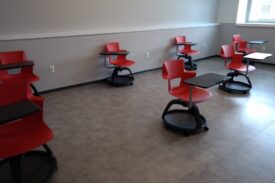The three local Catholic colleges and universities have released their respective Fall 2020 reopening plans adhered to the safety guidelines provided by the State’s Department of Health and by the Centers for Disease Control and Prevention. As the number of days until the first day of classes dwindle, students have mixed feelings about the new semester during the age of COVID-19.

St. Francis College’s “Back to Brooklyn” Plan
St. Francis’ phased return-to-campus plan, better known as the “Back to Brooklyn” plan, revolves around two principles: minimizing the risk of COVID-19 transmission while delivering a stellar Franciscan education experience dedicated to student success and achievement.
St. Francis requires all members to sign the Terrier Pledge, a personal commitment to act responsibly in accordance with the new rules in place.
As announced in mid-June by Dr. Jennifer Lancaster, vice president for academic affairs and academic dean, classes will run as previously scheduled from Sept. 9 to Dec. 21, under a flexible hybrid model. This model entails three options: blended hybrid, online set-time, and online self-paced. The blended hybrid options call for on-campus instruction at scheduled times during the week (usually once a week); online, live office hours with professors; and sections with live, online course meetings during the week or sections with self-paced online meetings. The online set-time option, which is considered synchronous, features live online instruction at scheduled times during the week. The online self-paced option, which is considered asynchronous, features online learning with no scheduled course meeting time.
Like those enrolled in the nursing and science programs, some students will have priority in attending in-person, hands-on clinical instruction, and labs at least once a week. Other students may be allowed to come to campus — as safety requirements allow and under a maximum capacity rule — to access computer labs to complete coursework, meet with advisors, and hold some meetings for student groups (pending advance approval).
International cultural studies major Xena Cuevas ’23 transferred from a Southern California college to St. Francis last year because she wanted to excel in a smaller environment. This semester, Cuevas is registered to take five courses, but she’s not sure how she’ll be taking them yet.
“There are a lot of students who are very scared of what’s going on with the virus,” she continued. “For me, I would love to go on campus for classes, but not every day, because it’s a whole different experience than learning online.”
Cuevas, who has enjoyed her classes and professors so far, believes St. Francis has been doing a good job educating its students and providing access to facilities and resources like on-campus computers. She currently has a hold on her account because she needs to pay previous fees — but said she feels more at ease after speaking with the college’s financial aid department.
“They told me, ‘Don’t worry about it, don’t think about that right now,’ ” Cuevas said. “Everybody who has a hold is allowed to register, and I think that’s understandable.”
“Honestly, I would be willing to pay what was agreed on because I know how much St. Francis gives back. But if the administration could be understanding about this [pandemic] for other students, that would be ideal,” she said. “I spoke with my financial aid advisor recently, and he said that the tuition and fees would be the same. That’s something I definitely did not agree with.”
The 2020-2021 tuition and fee rate for a full-time undergraduate student is $26,798 according to St. Francis’ website. Cuevas explained that she has to pay a fee for a lab that she most likely won’t be using this semester. She was advised to talk to the professor about the matter and to keep an open line of communication line.
Despite some of the uncertainties students will be facing this semester, including whether or not they will have the typical college experience, Cuevas believes St. Francis is on the right path. “I think, so far, they’re doing their best, and it’s understandable with reimagining the next semester.”
St. John’s University’s Fall Semester Plan

St. John’s will resume classes both in-person and online, as well as reinstate dorming on its Queens and Staten Island campuses. On its “Preparing for the Fall Semester” web page — last updated on July 15 — two essential lessons were listed as important to remember: adaptability and flexibility to change, and the recognition that individual actions are fundamental to keeping the community safe and healthy.
St. John’s will require members to fill out the “COVID-19 Symptom Screening” questionnaire on a daily basis within the St. John’s app or on the website (prior to stepping foot on campus). Similar to St. Francis, all St. John members will be asked to sign the “Johnnies Care Compact,” a statement of mutual commitment to community health and behavioral standards that every student, faculty, administrator, and staff member will follow.
Most classes will begin on Aug. 24 (instead of Sept. 2, which was the pre-COVID-19 date) and will continue through Nov. 20 with the following options available: on-campus, in-person; traditional hybrid; rotating hybrid; and completely remote. The hybrid classes will give students the opportunity to attend some classes on campus and attend other classes (with either asynchronous or synchronous components) remotely. Students will then return home for the week-long Thanksgiving break (Nov. 23 to 28) and finish their remaining coursework and final exams remotely from Nov. 30 to Dec. 8.
Public relations major Cera Perry-Johnson ’23 will be taking five, online-only classes in the fall. She was originally dorming on the Queens campus but will be continuing to live at home because of the pandemic.
“I’d prefer to have in-person classes, but COVID-19 isn’t settling down and there’s likely going to be a second wave,” Perry-Johnson continued. “By doing remote classes, I’m essentially keeping myself safe.”
Perry-Johnson, like other enrolled students, was upset when St. John’s announced a three-percent increase in tuition and a two-percent increase in room and board costs in early July. The base tuition for distance learning and traditional students (including those enrolled at the main Queens campus) was raised $1,260, now totaling $43,160. The base tuition for traditional students at the Staten Island campus is now $30,810 — a $900 increase from last year’s rate. A group of students and local residents rallied at the Queens campus on July 15 to voice their concerns about the tuition increase, demanding a freeze instead.
“It’s obvious they don’t care about their students enough to freeze or lower tuition for the 2020-2021 school year. The school is being very tone-deaf with this situation right now,” Perry-Johnson said.
Though she receives grants and scholarship aid (so long as she maintains a 3.0 GPA) each academic year, Perry-Johnson has also taken out a few small loans to pay for her undergraduate education.
“We are in a pandemic where people have lost their jobs or have been furloughed,” she said. “Taking out more student loans is not ideal because of how much that interest grows. Student loans will follow us forever.”
Perry-Johnson said she also noticed a brand new fee on her latest bill. “That has yet to be discussed or explained to students and parents,” she said. “I’ve asked about it and they’ve just kind of avoided the question.”
In May, a proposed $5 million class-action lawsuit was filed by Shiv Patel, an undergraduate student from the Queens campus, against the university. He claimed St. John’s refused to refund tuition and other service fees that had already been paid for when the university was forced to implement distance learning midway through the spring semester.

St. Joseph College’s “Ready. Set. Reopen” Plan
St. Joseph’s announced that it will be offering four learning methods when classes begin on Sept. 9: remote, hybrid, on-ground, and online. The remote option — which will be predominately used by faculty this semester — involves students meeting with professors and classmates at regularly scheduled times via a video platform. The hybrid option combines both virtual and in-person learning, meaning students will be on campus for half of the course sessions and online for the other half. If a student chooses to take part in the on-ground option, they would return to campus and learn as they had during a normal semester before the pandemic emerged. The online option, which is different from the remote option, means students will take their classes in an asynchronous manner with no pre-set schedule and without interaction with other students and faculty.
Emely Abreu ’22, who is majoring in recreational therapy, is very active on the Brooklyn campus. She is president of the college’s Campus Ministry & Outreach Club and a member of the SJC Diamonds Dance Team, Recreation Club, and Poder Latino Club. One of Abreu’s main concerns is how student-led clubs and organizations will continue to function amidst a pandemic.
“With the Campus Ministry & Outreach Club, for example, we’re in the process of recruiting new members, getting the word out, and planning out our semester. I’m worried people might not get the chance to have that encounter with God through the club,” she said. “We’re trying our best, but we’re not limited — God can work many great wonders through a screen.”
Abreu said she’s also concerned about other students’ mental health since they’ve been living at home for the last few months.
“If you’re buried behind a screen all the time and might not be able to see your friends as much as you used to, you may get in your own head,” she continued. “I’m worried about the lack of resources that students might be missing from not being on campus.”
Abreu planned out her fall schedule with her academic advisor and has decided to take 18 credits. She’s choosing to take some classes through the hybrid format because she craves the social aspect of school and doesn’t want to sit in front of a computer all the time.
“It’s a lot to juggle,” she admitted. “I usually wouldn’t do the same thing if I would have been on campus — but since most of my other classes are online, hopefully, my time management skills will be better, and I can get more credits out of the way.”
Abreu noted that she and her classmates transitioned very well to remote classes in the spring and that most professors were understanding of students’ at-home situations when completing assignments. However, she became worried about the financial aspect when partial refunds were not given for gym access or technology fees.
“I don’t dorm, so I don’t have to worry about those fees, but I felt like at least half a semester’s worth could’ve been refunded for the other on-campus-related fees,” she said.
